NVIDIA GeForce GTX 650 Ti Boost Review: Bringing Balance To The Force
by Ryan Smith on March 26, 2013 8:00 AM ESTPower, Temperature, & Noise
Last but not least of course is our look at power, temperature, and noise. Because the GTX 650 Ti Boost is essentially a reconfigured GTX 660 there aren’t going to be any grand revelations here, but it will be useful to figure out just what the real-world power savings will be from fusing off that one SMX.
| GeForce GTX 650 Ti Boost Voltages | ||||
| Ref GTX 650 Ti Boost Idle | Ref GTX 650 Ti Boost Load | Ref GTX 660 Load | ||
| 0.887v | 1.175v | 1.175v | ||
With a peak load voltage of 1.175v, the GTX 650 Ti Boost tops out at the same voltage as the rest of the boost-enabled Kepler family.
Up next, before we jump into our graphs let’s take a look at the average core clockspeed during our benchmarks. Because GTX 650 Ti Boost has the same TDP has the GTX 660 but at least marginally lower power consumption due to the disabled SMX, it’s in an interesting position where it has more headroom for boosting than its fully-enabled counterpart. As a result we’re seeing far less variability than what we saw with the GTX 660 when we reviewed it last year. With the exception of BF3, every game is sustained at the top boost bin of 1071MHz. Based on these results it would appear that in practice the GTX 650 Ti Boost operates at a marginally higher average clockspeed than the otherwise superior GTX 660.
| GeForce GTX 650 Ti Boost Average Clockspeeds | |||
| Max Boost Clock | 1071MHz | ||
| DiRT:S |
1071MHz
|
||
| Shogun 2 |
1071MHz
|
||
| Hitman |
1071MHz
|
||
| Sleeping Dogs |
1071MHz
|
||
| Crysis |
1071MHz
|
||
| Far Cry 3 |
1071MHz
|
||
| Battlefield 3 |
1058MHz
|
||
| Civilization V |
1071MHz
|
||
| FurMark | 992MHz | ||
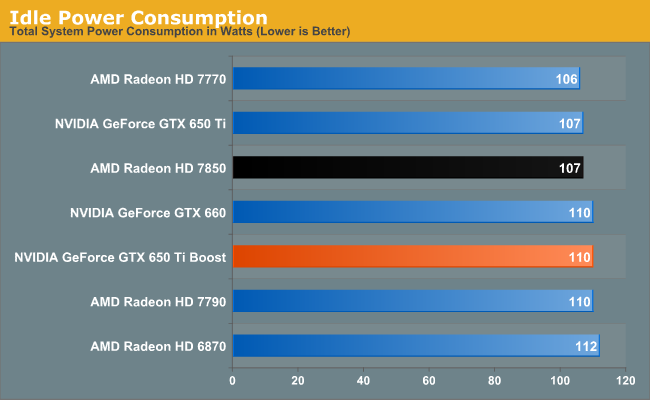
Starting as always with idle power, 110W at idle is par for the course for most NVIDIA cards. With the reactivation of the 3rd ROP partition the GTX 650 Ti Boost gives up the slight advantage the GTX 650 Ti gained here.
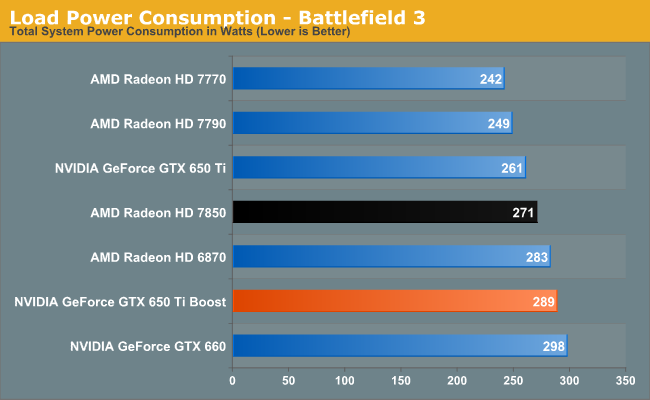
Moving on to our first and arguably most important load power test we have BF3. Power consumption in BF3 scales slightly with performance due to the extra work required of the CPU to feed more frames to a video card, but it usually paints some clear trends and this is no exception. NVIDIA may only be giving the GTX 650 Ti Boost a official TDP 6W lower than the GTX 660, but it’s clear power consumption is at least a little bit lower than that; we’re seeing 289W at the wall versus 298W for the GTX 660. On the other hand these results are 28W higher than the GTX 650 Ti, and even 18W higher than the 7850, never mind the 7790. The GTX 650 Ti Boost’s performance here is well ahead of everything other than the GTX 660, so this jump in power consumption does come with a performance boost, but it serves as a reminder that there is a tradeoff to be made. In the case of the GTX 650 Ti Boost, we’re seeing it pull away a bit from the efficiency curve set by NVIDIA’s other products.
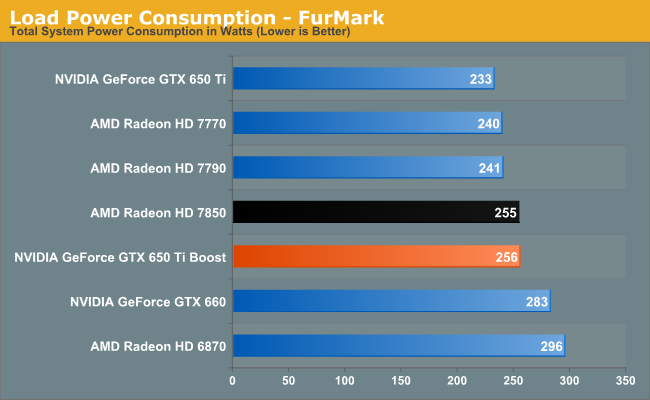
As for power consumption under FurMark, we’re seeing the more muted results for the GTX 650 Ti Boost. Here it’s roughly halfway between the GTX 650 Ti and GTX 660, and probably should be a bit higher still. The fact that there’s a difference (at the wall) of 27W between the GTX 660 and GTX 650 Ti Boost is more than we would except, and more than makes sense for cards that are identical except for a single fused off SMX. So we may also be seeing chip-to-chip variation play a part here. In any case, power consumption is also similar to the 7850, but this is one of those scenarios where we put more faith in the BF3 numbers than the FurMark numbers; NVIDIA appears to just outright be more aggressive on throttling here.
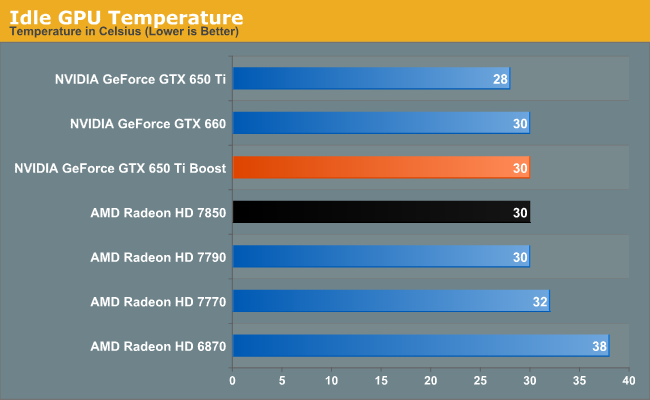
Utilizing the same cooler as the GTX 660, there’s no surprise here in seeing the GTX 650 Ti Boost hit the same 30C idle temperatures.
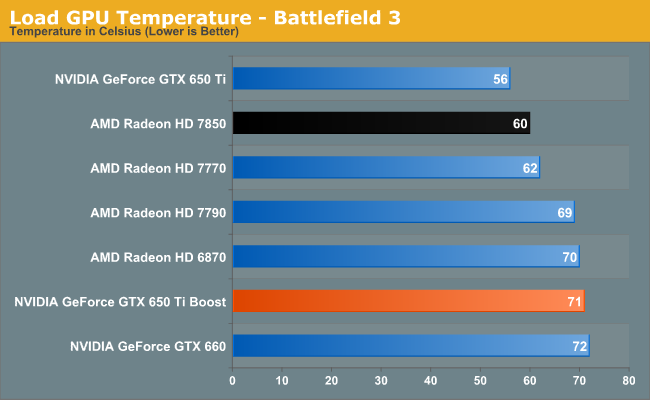
Similarly, our temperature results here closely parallel the GTX 660’s under load. The GTX 650 Ti Boost consumes a bit less power than the GTX 660, and doesn’t get quite as warm as a result. The large jump from the GTX 650 Ti comes as a bit of a shock to the eyes at first, but as the GTX 650 Ti Boost is a blower and one with a conservative fan curve at that, this is to be expected.
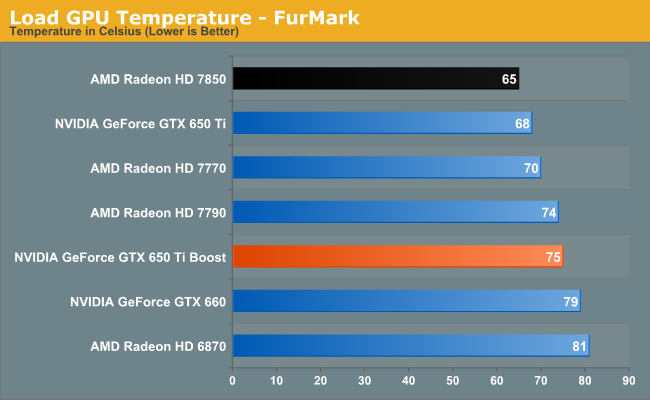
With FurMark we see temperatures go up, but for the most part things are consistent with what we saw under BF3. The larger gap between the GTX 650 Ti Boost and GTX 660 reflects the larger gap in power consumption we saw earlier.
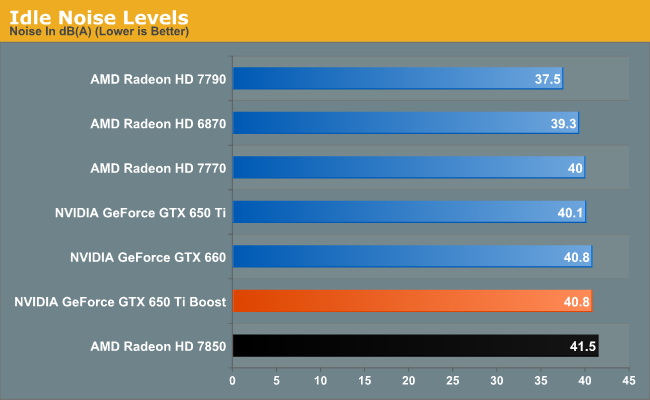
Just as with idle temperatures, the same GPU on the same cooler means we’re looking at the same idle noise temperatures. The blower NVIDIA uses here is quite good, but it can’t compete with simple open-air coolers like the 7790’s.

There’s a clear cutoff here between the open-air coolers and the blowers. The GTX 650 Ti Boost is quite a bit faster than something like the 7790 here, but the difference in noise is remarkable. Some of NVIDIA’s partner cards should fare much better here as they pack open-air coolers, with the usual tradeoff of giving up being fully-exhausting coolers. Still, this is a reminder that the GTX 650 Ti Boost pulls back from the efficiency curve a bit; it’s about 15% slower than the GTX 660 but no quieter for it.
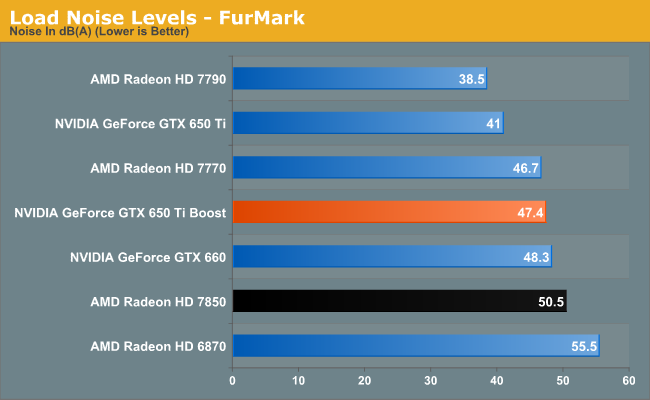
Finally we have load noise under FurMark. NVIDIA’s more aggressive throttling here means that our results don’t jump up to much from BF3. The GTX 650 Ti Boost does finally end up being a bit quieter than the GTX 660 due to the former’s lower power consumption, and this is the only time we see the GTX 650 Ti Boost gain an edge on the 7850 in power/temp/noise.










78 Comments
View All Comments
Eugene86 - Tuesday, March 26, 2013 - link
Overclocking is not a guarantee, apart from the fact that it shortens the lifespan of the card itself, all it does is increase power consumption (which negates your power consumption argument) and it also wastes your time by having to have to tinker with drivers and overclocking speeds to make sure the card doesn't artifact and such. Considering the subpar quality of AMD drivers, this is something that no one wants to waste their time on except for fans of AMD.stickmansam - Tuesday, March 26, 2013 - link
Have you tried to OC the 7850 yourself? I hit 1ghz without any voltage or power tweaksIt is way under clocked at 860mhz.
Haven't run any power draw comparisons yet though myself
cyrusfox - Tuesday, March 26, 2013 - link
So true, 7850 hits 1050 MHz easy breezy. It was a great card and it has held its value, I originally got it for $150 second hand when it first came out(forum shopping). I'm surprised to see it still being valued higher than that.From my personal experience, the 7850 is a guaranteed 1 GHz card. But a lot of people don't OC so they miss out on the potential. Nvidia does have its positives and the boost seems like a good card to fill the holes in the market.
anubis44 - Thursday, March 28, 2013 - link
I hear what you're saying -- in the past, people would say that you could overclock a model of card to some ridiculous speed that only 5% of the cards of that model could reach with stability, and then say that the entire model of card performed that way. A couple of times, I was tricked by this kind of nonsense, and regretted swallowing it from idiots on a chat forum.But in the case of the 7850, this is the real deal. I kid you not, there is probably not a single one that won't go up to 1050MHz with just the AMD video driver and a couple of fisher-price sliders and not even any additional voltage. I defy you to find somebody who has tried this, and been unable to clock it up to at least the 1050MHz max in the video driver, without any extra volts. It's the best kept secret in the video card market right now, almost like the Celeron 300a back in the day, that would clock from 300MHz to 450MHz with just a multiplier adjustment in the bios. It's like AMD just left 40% more performance on the table with the 7850. I had two of them myself for about a week, and it was ridiculous how much faster they would go if you just bothered to take 2 minutes to bump them up from 860MHz to 1100MHz-1150MHz. I can picture AMD getting slightly irritated at nVidia for trying to reach the 7850's default speed with this piddly GTX650 Ti Boost, and turning around and releasing a GHz edition bios for all 7850 owners to just flash their cards to 1050MHz, kinda of like they did for the 7950.
k2_8191 - Tuesday, March 26, 2013 - link
IMO The new card is good deal if I consider only gaming performance per price.However, as a distributed computing junkie, I would still recommend the participants to choose some RADEON HD 7k cards for double-precision workunits (HCC in WCG in particular).
Bob Todd - Tuesday, March 26, 2013 - link
One simple and obvious answer, Never Settle Reloaded. The 7850 is faster in most games, destroys it compute, and you get Tomb Raider and BioShock Infinite for free. Even if you have no interest in either game, you can easily get ~$50 (after fees) for the codes on eBay. Nice 2GB 7850s have been on sale regularly for $170. That means you can get a faster 7850 2GB for ~$120. So does $150 for a 1GB 650 Ti Boost sound better than $120 for a 2GB 7850? 1GB 7850s have hit $150. Bottom line is that it's great time to be a budget gamer. The 650 Ti Boost, 7790, and 7850 are all good cards in the pricing sweet spot for a lot of people. Never Settle Reloaded puts things squarely in AMDs hands from a "value" perspective though. Whether or not you want the games, they are quick sells, and even the 7790 would really be in the ~$120 range if you wanted to sell BioShock Infinite.Parhel - Tuesday, March 26, 2013 - link
Thanks! Based on your post, I did a bit of shopping, and found an MSI 7870 @ Newegg. $220 list price minus a $25 rebate, ~$50 on reselling the bundle, and ~$30 on reselling my GTX 460, and I should be at about $115 for a 7870. Not too bad considering they were ~$350 at release.Bob Todd - Tuesday, March 26, 2013 - link
You just reminded me that I need to decide if I'm selling my GTX 460. I looked on eBay a few weeks ago and the same 1GB model sold for ~$60. Part of me thinks it isn't really worth it and I should just keep it as a backup or a hand-me-down upgrade for a family member. But the smarter part of me knows it will probably just sit in its box in my closet for years.just4U - Wednesday, March 27, 2013 - link
I think you can get a bit more for the 460.. $60 is a fair price for it.. imo. Also "HIS" seems to offer the best deals on the 7870 (when they come up for sale..) Not sure if you can really get $50 for the bundle tho.. hah can always try!Bob Todd - Wednesday, March 27, 2013 - link
YMMV of course. However I've sold two for that much, with the listings lasting less than 12 hours. And most people are happy to just get the code via email so you might not even have to ship anything.